4 factors that will decide Game 7 of Raptors-Celtics
The Boston Celtics were 0.5 seconds away from taking a 3-0 lead in their second-round series against the Toronto Raptors. But after the Raptors stole Game 3 at the buzzer, leveled the series in Game 4, and bounced back from a Game 5 beatdown with an insane double-overtime win in Game 6, this epic Eastern Conference semifinal is going the distance.
The series has been a defensive battle, a physical and psychological endurance test, and a tactical chess match, with all manner of adjustments and counter-adjustments. Here are four factors that will determine how Game 7 shakes out.
Siakam's offensive role
Pascal Siakam has struggled miserably at the offensive end in this series. Through six games, he's produced a 43% true-shooting mark, having hit just 38.2% from floater range (where the majority of his shots have come from) and 12.9% (4-for-31) from three. Rough.
The Raptors still rely on him immensely because of his defense, which has more than made up for his offensive foibles. Between his on-ball work on Jayson Tatum, his timely rotations to contest shots at the rim, and his help-and-recover closeouts to the 3-point line, Siakam was the best defender on the floor in Game 6, which is why he played a game-high 54 minutes and was a game-best plus-12 in those minutes despite shooting 5-of-19 from the field.

There's been plenty of talk about how Toronto can get Siakam going offensively in this series. After a blowout Game 5 loss, Nick Nurse and Kyle Lowry both stressed the importance of involving him more. That's understandable; Siakam was the team's No. 1 scorer during the regular season, and his struggles have put a ton of pressure on Lowry and Fred VanVleet to carry the scoring and playmaking load. But running the offense through Siakam - whether by having him initiate from the top, letting him face up from the wing, or force-feeding him post touches - hasn't been fruitful. The Celtics have done a tremendous job of defending him on-ball, so featuring him in that role may not be the answer.
Siakam's post-ups on Jaylen Brown and Marcus Smart have resulted in a lot of empty trips; those guys have denied him deep position, forced him away from his strong hand, and crowded his dribble. In spite of that, he's posting up 6.7 times per game in the series, up from 3.9 in the regular season and 3.3 in the first round.
His face-up game has been similarly spotty. Siakam's never had the tightest handle, but it's been particularly shaky following the hiatus. He isn't changing direction well, which has allowed Boston's defenders to anticipate his driving angles, sit on his inside-out dribble, and stay in front of him, often drawing offensive fouls. His struggles to beat guys off the bounce have also forced him to settle for pull-up jumpers, which have been objectively bad in the bubble. He's shooting 22.2% off the dribble in the playoffs, including 0-of-16 from three.
And while he's found some success attacking Kemba Walker on switches, the Celtics have done a bang-up job of avoiding the mismatch. One of their methods of doing so has been using scram switches to kick Walker out of the matchup and replace him with Smart before Siakam has a chance to attack. This one in crunch time of Game 6 was a thing of beauty:
Even Siakam-small pick-and-rolls with one of Lowry or VanVleet as the screener, which were so successful in the regular season that they became the Raptors' go-to sets in crunch time, have produced very little. That's largely a credit to Walker for how effectively he's hedged, preventing Siakam from turning the corner and getting downhill, sometimes completely stopping him in his tracks:
The Raptors will likely be best served using Siakam in a predominantly off-ball role in Game 7. Let him spot up and curl from the corner, cut from the weak side, scavenge for buckets in the dunker spot, try to get in rhythm shooting off the catch, and preserve his energy for the defensive end. That doesn't mean he shouldn't have plays run for him. The Raptors have used the odd baseline cross-screen to get Siakam an advantage close to the basket, and while his touch hasn't always been there, he's gotten good looks. They should make room for more of this:
If Toronto wants to involve Siakam in the central action, he should be screening more often than handling, particularly when they go small. The Raptors have barely scratched the surface of his utility on the other end of pick-and-rolls, and at the very least his roll gravity should open things up for Lowry and VanVleet in a way Marc Gasol's doesn't.
Siakam will have a crucial part to play in Game 7 one way or another. The extent of his impact will have a lot to do with how the Raptors deploy him on offense. - Joe Wolfond
Boston's ability to work the corners
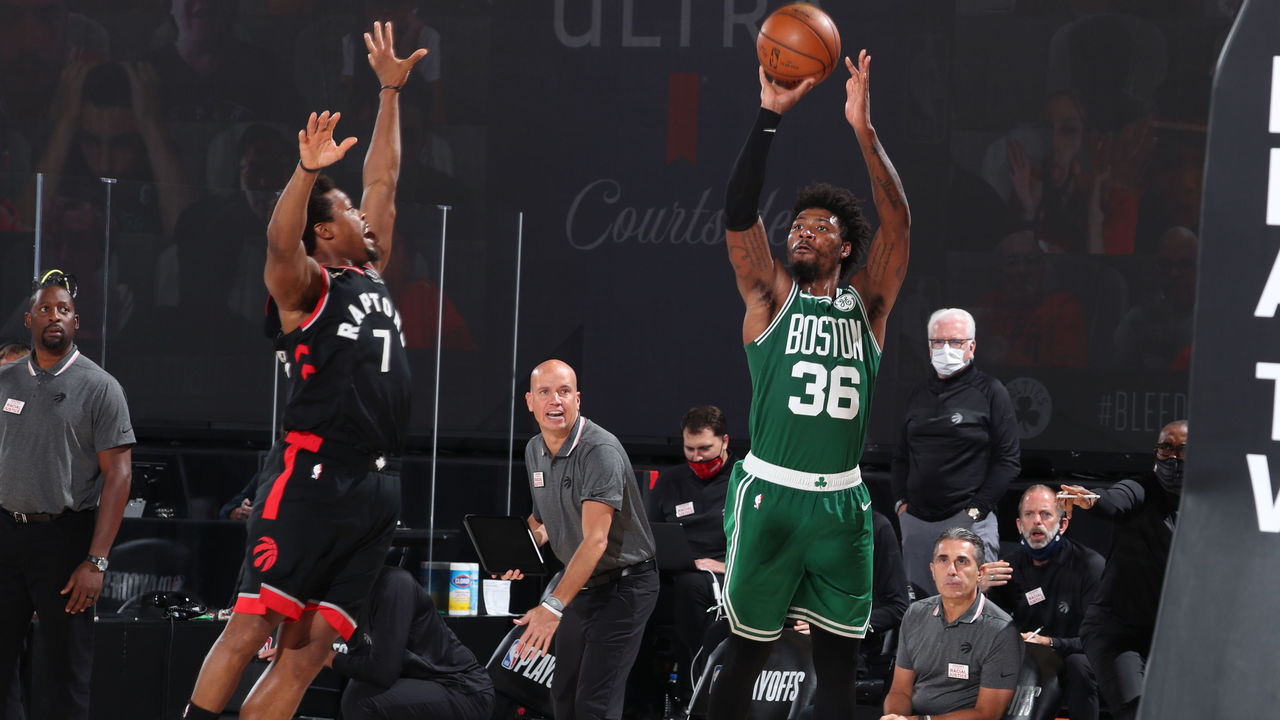
The Raptors boasted the league's second-best defense this season, defended far better during the seeding games than any of the 21 other teams that traveled to Disney World, and have earned a reputation as the most creative and adaptive defensive team under Nick Nurse.
But every great defense has to sacrifice something in order to fully commit itself to its schemes and overarching principles. For Toronto, that sacrifice involves the 3-point line. On a per-game basis, only the Bucks (39.3) gave up more than Toronto's 38.9 opponent 3-point attempts per game, and on a per-possession basis, the defending champs surrendered more threes than anyone else. A league-high 44% of Raptors opponents' field-goal attempts came from beyond the arc.
The thing is, it didn't really burn them.
Between Nurse's ingenuity, and the Raptors' collective basketball IQ, defensive ability, and length, Toronto proved to be the rare team capable of defending the rim and loading up on opposing stars while also still being able to guard the 3-point line.
Led mostly by the versatility and mobility of Siakam and OG Anunoby, the Raptors often got away with their creative double-teams because that aggressive help-defense was still able to cover enough ground and recover to challenge the perimeter shooters whom they helped off of in the first place. That's how you can give up more 3-point attempts than anyone else but also rank first in limiting opponents' 3-point percentage (33.7%), which Toronto did this season.
In a series largely defined by great defense flummoxing good offense, the Celtics have found some offensive success by being the first team to truly make the Raptors pay for their high-risk, high-reward defensive scheme.
The key for the Celtics has been having their wealth of shot-creating talent move and manipulate the Raptors' defense until the most analytically friendly of 3-point attempts - one from the corners - presents itself.
One such stretch early in the fourth quarter of Game 6 highlighted Toronto's vulnerability as well as Boston's strategy and unique ability to punish the Raptors.
Over a span of just 2:13 (between the 10:35 mark and 8:22 mark), the Celtics generated four consecutive open 3-pointers - three of which came from the corners - to spur a 12-4 run that helped Boston turn a seven-point deficit into a one-point lead.
On the first of the four, you can see below how the Raptors' star-stopping defense is devoting its full attention to Kemba Walker, who's about to make a pass to Jayson Tatum:
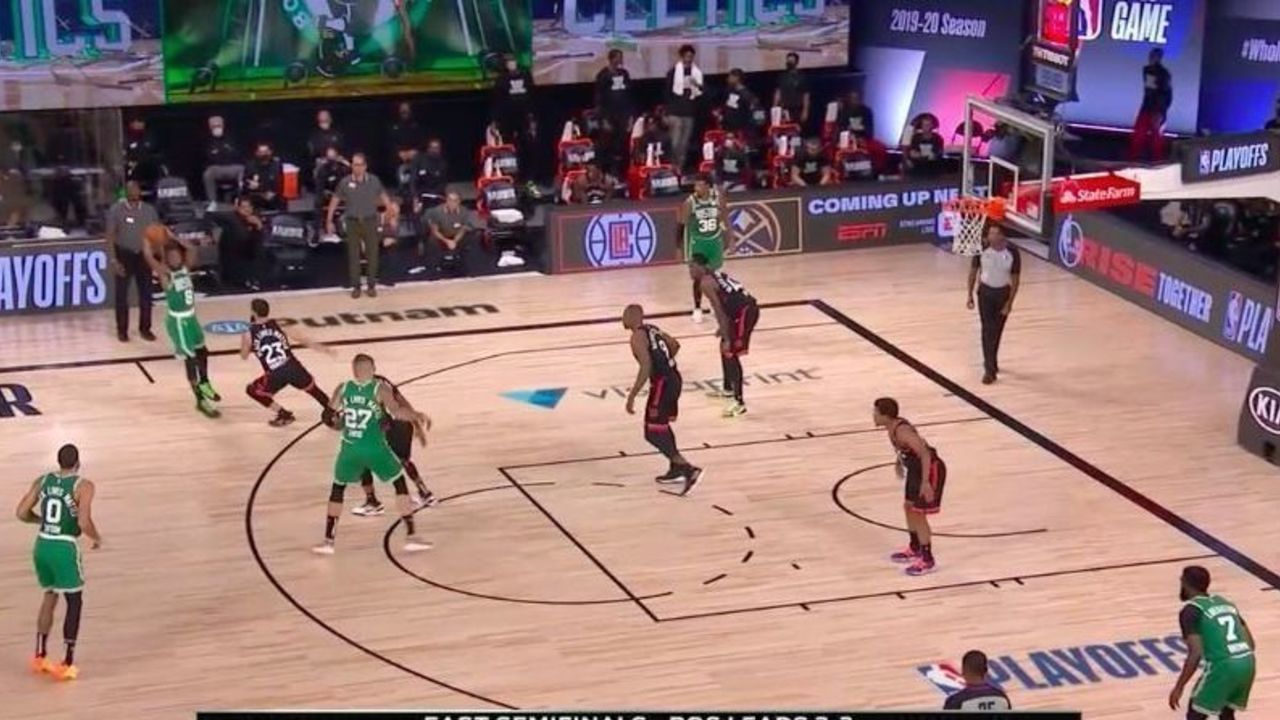
Lowry then closes out on Tatum, who finds Jaylen Brown for a wide-open bucket from the weak-side corner.
On the second 3-pointer, you can see below how Walker's drive has attracted multiple defenders. Norman Powell has to decide between closing down the space on Tatum above the break or Brown in the corner.

Tatum is the better shooter, but most teams would still opt to guard the corner. Powell and the Raptors choose Tatum, and Brown knocks down his second consecutive triple.
On the third, you can see below that after Walker again draws attention on the perimeter and Daniel Theis begins his roll after a pass from Walker on the pick-and-roll, Siakam helps off Marcus Smart in the weak-side corner:
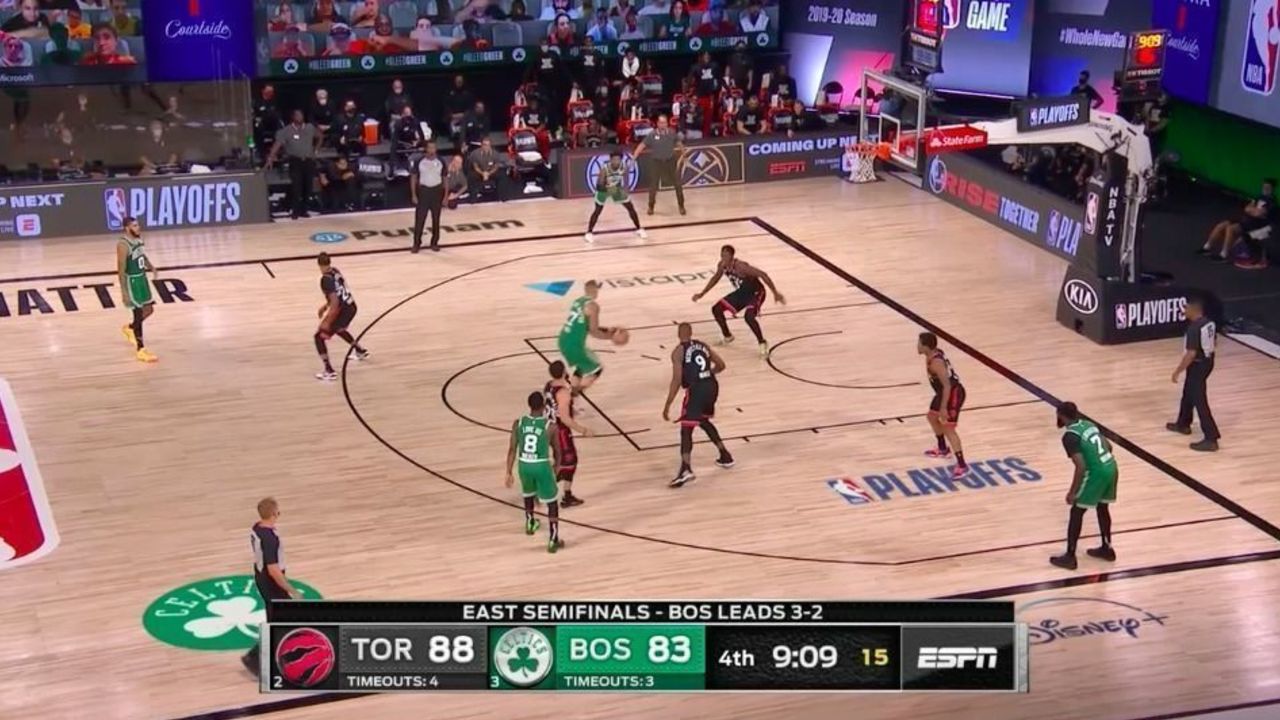
Theis makes the easy pass, and Smart converts for another three points.
Finally, the fourth triple involves all three of Boston's star shot-creators. After Walker had already shifted the Raptors' defense, Brown caught the ball in the corner, attacked a Lowry closeout by driving baseline, and found himself the center of attention for all five Raptors on the floor. At the same time, you can see Tatum - his right arm raised - calling for the ball above the break.
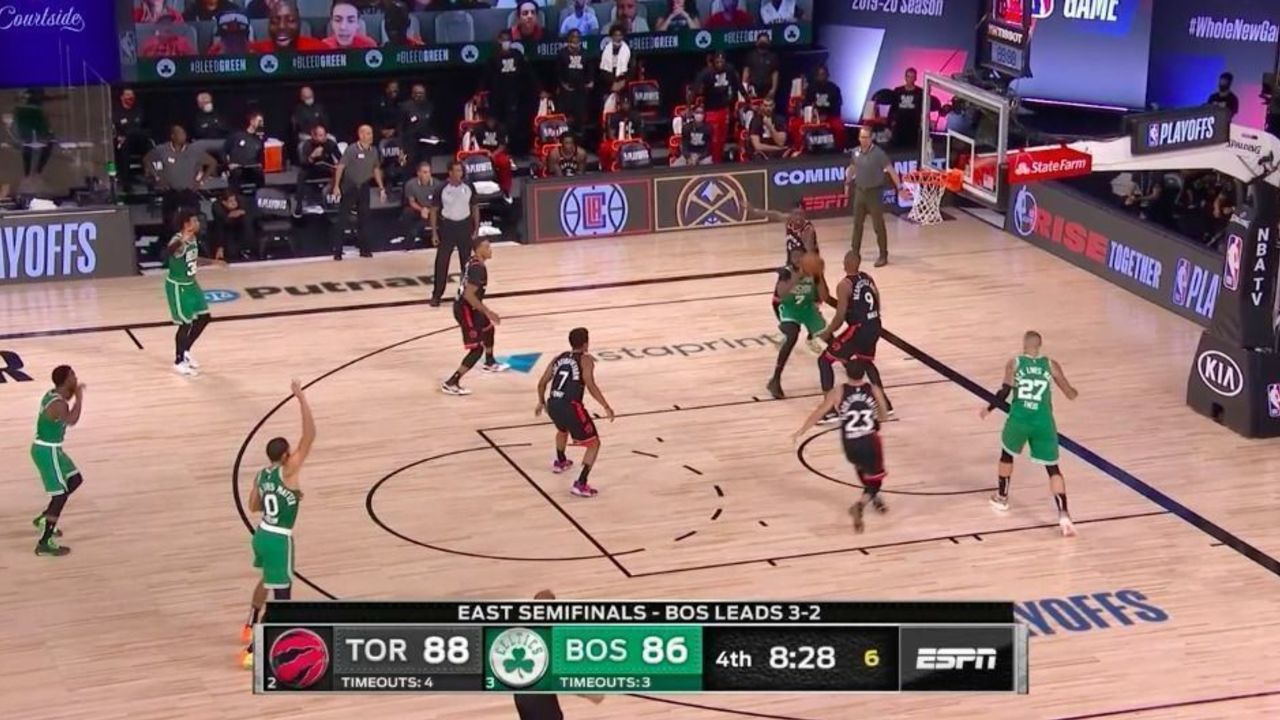
Tatum knocks down another open three, and the Celtics find themselves with a lead in a potential closeout game.
The Raptors' defense is designed to be versatile and mobile enough to both overload on stars and recover back to shooters who usually aren't as capable as the players whom Toronto is trying to shut down. Compared to most NBA defenses, the Raptors will also often ignore weak-side corner threats for an extra second or two in order to have that threat's defender provide an extra body of resistance in the paint.
The challenge the Celtics present is that all of Walker, Tatum, and Brown are capable of being the type of shot-creating stars who the Raptors would usually be focusing their attention on. The Raptors can load up on one and perhaps even competently recover to the second Celtic in the chain, but even the most fluid, disciplined defense eventually reaches a point of no return. The Celtics' trio is capable of pushing its opponents to that breaking point, and that's without mentioning Smart, whose improved shooting makes the shot creation of Boston's stars and the aggressiveness of the Raptors' defense even more dangerous for Toronto.
Going small, as the Raptors did down the stretch in Game 6, should allow the champs to rely less on help defense and more on their own collection of rangy wing defenders to man up on Walker, Tatum, and Brown. But there will still be large stretches of Game 7 where Toronto overhelps, and if the Celtics can continue to create the same looks and catch fire at any point, they may find the spurt that helps break a winner-take-all game wide-open. - Joseph Casciaro
Raptors' small-ball lineup
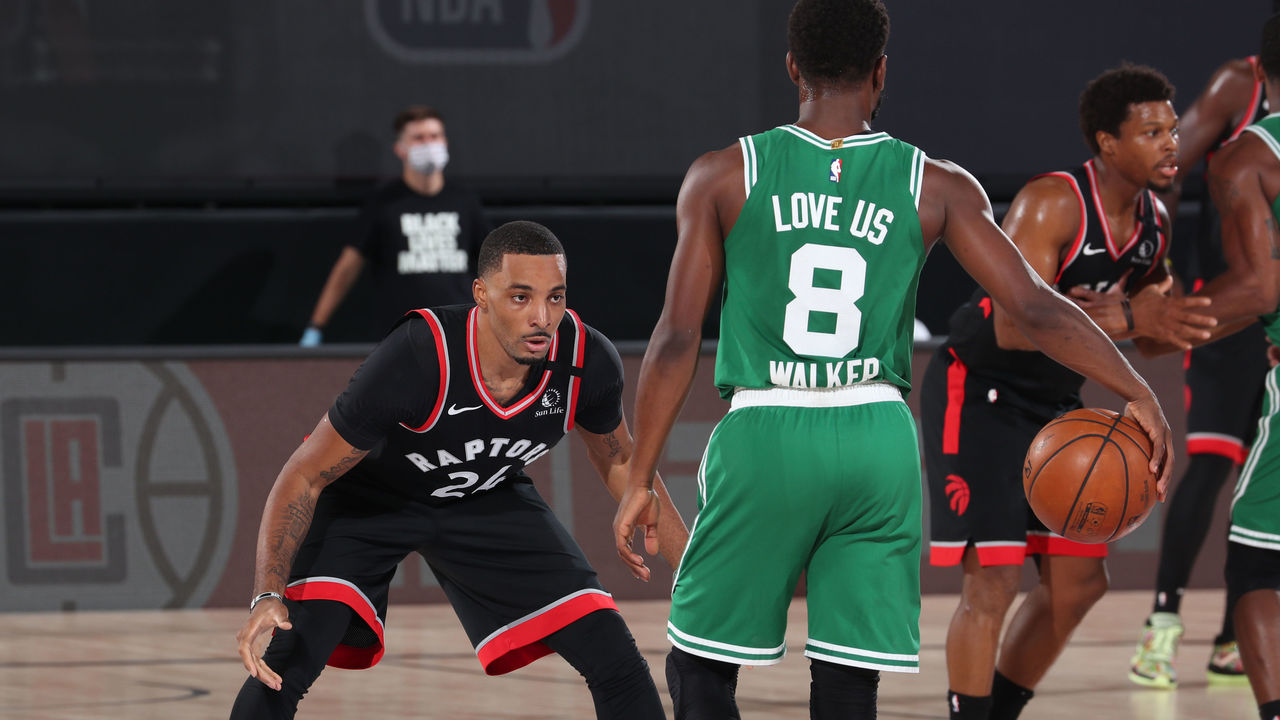
Here's the thing: Three of the four 3-pointers cited above happened because the Raptors were covering for Serge Ibaka.
Ibaka has struggled to deal with Boston's high-screen actions - especially those involving Walker - all series. He often provides the worst of both worlds, dropping back without actually containing the drive. The ankle injury he sustained in Game 5 seemed to exacerbate the issue, and his poor positioning kept putting the Raptors in emergency help-and-scramble mode. The Celtics posted a tidy 120 offensive rating with him on the floor in Game 6.
After the last of those four triples gave Boston the lead, Nurse called a timeout, yanked Ibaka, and, rather than reinsert Gasol with five fouls, decided to go small with Anunoby at the five. Against a Celtics team that has more skill than size up front, it made sense for the Raptors to try downsizing. Nurse later said the decision was "about three games in the making."
To that point, the lineup of Lowry, VanVleet, Siakam, Anunoby, and Powell had played just 12 minutes together (two in the regular season and 10 in the playoffs, including a short throwaway stretch in the Game 5 blowout). But that fivesome proceeded to play the final 8:22 of regulation and both overtime periods, outscoring the Celtics 37-33 to pull out the season-saving win.
If there was a reason Nurse resisted going small for so long, it was that both his centers had played significantly better than Powell, the only non-big on the bench whom he's felt comfortable playing in this series. The small lineup worked because Powell finally woke up after sleepwalking through the first five-and-a-half games. He poured in 15 points in the overtimes, hung tough defensively, and made arguably the biggest play of the game - picking Tatum's pocket and then taking the ball coast to coast for an and-1 layup to put the Raptors up four with 39 seconds remaining in double OT.
The benefits of downsizing tend to reveal themselves most prominently at the offensive end, but it was on defense where the smaller look really gave the Raptors a boost, at least initially. They switched more freely and closed space much faster. The 1-5 pick-and-rolls that had previously forced Ibaka and Gasol to either trap or drop back were now just getting Anunoby or Siakam switched onto Walker. The Celtics got bogged down in isolation and scored just nine points for the remainder of regulation.
Boston started to find some counters as the endgame wore on, namely by using Tatum, rather than Theis, as their primary screener. They had him slip those screens and flare out to the 3-point line to pull the help out of the lane and leveraged Theis' size advantage by stationing him behind the defense:
All told, the Raptors' small-ball unit played to a 94.3 defensive rating across those 18-plus minutes. It held the Celtics to just 2-of-9 from 3-point range, which is as notable for the suppression of volume as for the suppression of accuracy. Anunoby more than held his own on the glass and won all three jump balls he took.
It's worth noting that the Celtics also shot 9-of-11 at the rim during that stretch and that Toronto's offense was nearly as anemic as Boston's. Which is to say, the Raptors still very much need their centers in Game 7. Gasol's rim-protection and ability to neutralize both the drive and the dive in the pick-and-roll have been instrumental to the defense. He's seemed at times to be moving in cement but has by far the best individual defensive rating of any Raptors regular in the series. And Ibaka's 3-point shooting, short-roll scoring, and offensive rebounding have resuscitated Toronto's offense at moments when it appeared to be dying on the vine, including in the first half of Game 6.
Still, if Powell can be even half as good as he was Wednesday night, Toronto can afford to keep those centers on short leashes and rein them in at the first sign of trouble. The Celtics will be prepared with wrinkles of their own. Going small isn't a panacea for the Raptors, but it's a pretty nice card to have up their sleeves. - Wolfond
The physical and mental toll
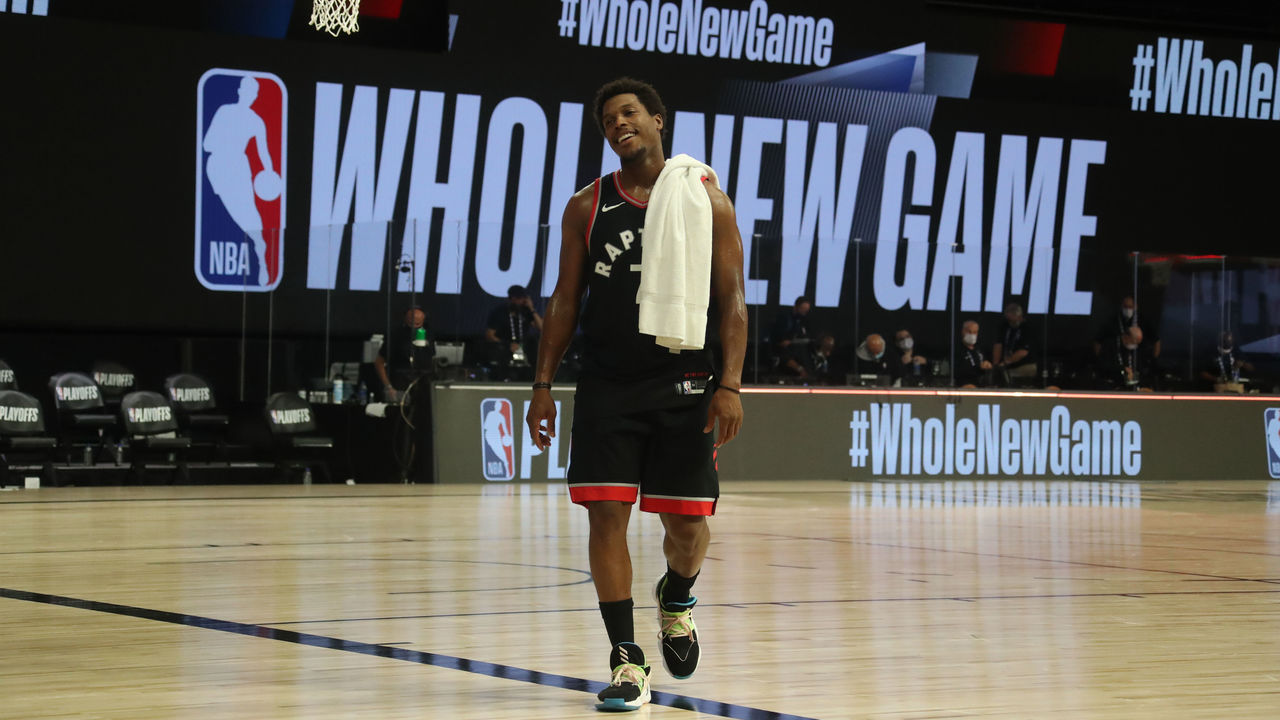
We've discussed tactical factors that will decide this series, but in a Game 7 setting of a matchup this taxing, we can't overlook the physical toughness and mental fortitude that are needed.
Of the nine players who played at least 49 minutes in the Game 6 slugfest less than 48 hours ago, eight are between the ages of 22 and 30. Then there's Lowry, who is 34 years old and in his 14th season. On one hand, Lowry is the type of no-nonsense workhorse who is difficult to envision losing out to fatigue with his season on the line. On the other hand, common sense says if anyone's going to be affected by Wednesday night's marathon, it would be Toronto's veteran leader.
For the Celtics, the struggle has to be more mental than physical at this point. Boston has been the better team in this series, has outscored Toronto by 32 points over six games, was 0.5 seconds away from taking a 3-0 series lead - with Tacko Fall, of all people, guarding a 6-foot inbounder - and missed out on plenty of opportunities to put the Raptors away in Game 6.
It's possible these young Celtics are too good and too poised to be rattled by the "woulda, coulda, shoulda," thoughts that would creep up on mere mortals in this situation, but letting the champs hang around for a Game 7 when you should've buried them days ago feels like flirting with disaster. - Casciaro